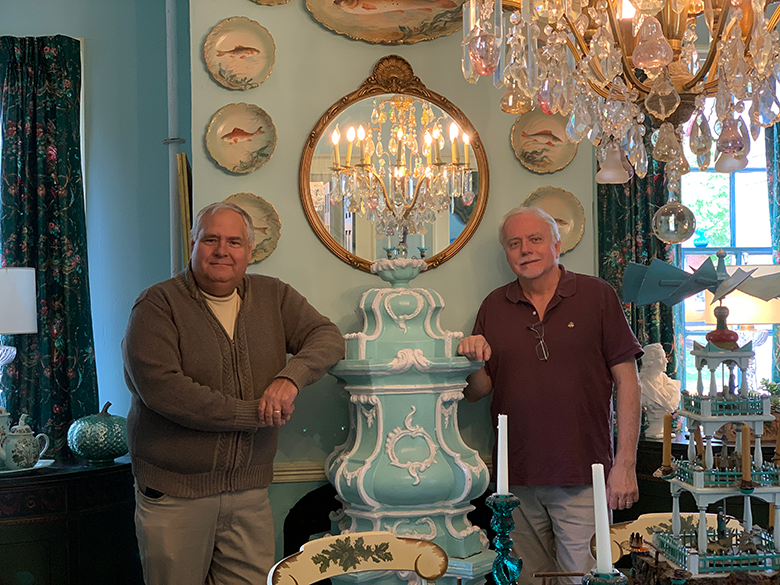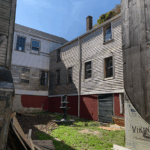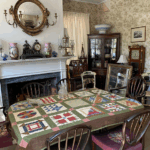One of Eastport’s behemothic houses—a remnant of the port’s mercantile legacy—has been saved from demolition. Beyond its historic value, the Isaac Hobbs mansion carries a vital connection to stories much larger than its own. One of the last stops on the Underground Railroad and the former home of Don Gellers, an attorney who worked on the Indian Land Claims case, the house has long been associated with society’s underserved.
“It was more a passion decision than a prudent one,” said James Pollowitz, who with his husband Bruce Ellis bought the house three years ago after moving from Connecticut to Cutler. “I was especially looking for a project that could preserve history, and a house that was most at risk.”
Having endured seven decades of neglect, the Hobbs house had a standing order for its attached carriage house to be demolished. It fit the bill perfectly for Pollowitz, who saw value in the property beyond its 10,000 square feet.
The house dates to 1816 when Isaac Hobbs, a carpenter who ran a mercantile business with his brother George, built the first story of the west wing. As Hobbs found success, he worked on expanding the dwelling, adding its Federalist body in 1823. Merchant Samuel Witherell bought the house in 1846 and added the east wing and a second story to the west wing in 1849.
Once purchased, the house required rapid triage.
“The east wing was really in the most critical shape,” said Pollowitz, noting it was near “imminent collapse” with three sides of its brick foundation exposed. After some searching, they were able to find a carpenter able to dig out the foundation and build a cement retaining wall.
In the meantime, the west wing—which was in equally bad condition but had a stable foundation—was converted into livable quarters with running water, electricity, and heat. In total, the house has 25 rooms, all with 10-foot ceilings, along with eight staircases and nine fireplaces.
Walking into the house today creates an impression of timeless opulence lent by the high ceilings and immaculate restoration work in the finished kitchen, dining areas, and parlor rooms, each of which are fully furnished with museum-quality antiques—a sensation put into quick juxtaposition by the as-yet unfinished portions that remain wrought by time.
While the house was made to showcase wealth, not every room was designed to that effect. Deep in the basement behind a chimney rests a small cubby about six foot long and four feet wide. Hidden by a sliding cloth, the cubby could hold two or three people—former slaves on their way to find freedom in Canada.
The restoration has uncovered occasional treasures, including Don Gellers’ rolltop oak desk. Gellers, who worked as a representative for the Passamaquoddy tribe, reportedly endured harassment culminating in a raid by the Maine State Police directly after filing the land claims suit.
“They knew exactly where his bedroom was, went there and ‘found’ six marijuana cigarettes,” Pollowitz said.
At the time, it was enough for Gellers to be disbarred and charged with a felony. He contested it, but to no avail, and eventually emigrated to Israel. After his death in 2014, Gov. Janet Mills reopened his case, and Gellers subsequently was awarded the state’s first posthumous pardon. Recognizing the importance of Gellers’ work, Pollowitz and Ellis donated the desk to the Passamaquoddy’s Sipayik Museum.
While some items have left the house, many more have since come in. Most are from Pollowitz’s collection, assembled over the years from museums and historic homes. Some incoming pieces were gifts donated by the house’s fanbase, represented in part by a 4,500-member Facebook group.
One such gift was a quilt that would have been hung from a window to signify the house was a safe place during the days of the Underground Railroad. Another gift came from a terminally-ill woman from the Midwest who came to Eastport to bring a toy chest built by Hobbs’ great-great-great nephew. It now sits in the restored tack room near a display case of horsemanship medals from another donor. Other gifts include two stunning chandeliers, one Venetian and one Napoleonic.
“The members of the Hobbs page have been my greatest wellspring of support and encouragement,” Pollowitz said. Many see the restoration of the mansion as inspirational for their own projects.
The restoration process, now about 60% complete, hasn’t been without its challenges.
“This is the epitome of a money pit,” Pollowitz said, though he refrained from estimating its cost. One problem is insurance, with several factors weighing against the house, including its coastal location and its condition. For the time being, it’s under contractor insurance, though Pollowitz hopes to expand the policy down the road.
He has been able to save money by learning to do some restoration himself—notably the original windows. “It’s very laborious, but it also saves a tremendous amount of money for other parts of the restoration.”
The largest remaining block to be restored is the east wing, which will house an upstairs library and additional bedrooms. Electrifying the bedrooms and restoring the fireplaces to working order will come in the future, further increasing the building’s livability.
The goal is to open the house for tours and events, with Pollowitz noting that around 100 guests recently came for a tour during the Salmon & Seafood Festival. Based on the favorable response, a traditional Christmas event is planned for Dec. 13, complete with carolers in period dress.
The restoration has been acclaimed by local residents, including Hugh French, director of the Tides Institute & Museum of Art.
“The Hobbs house is an extremely important building to Eastport’s unique historic architectural heritage,” French said, describing it as the “finest example” of a Federalist home and noting that it possesses the last Federalist period carriage house on the island.
“It could easily have been lost. What Jim Pollowitz and Bruce Ellis have done to save the house at a critical moment and make enormous strides in restoring it is extraordinary.”
Pollowitz feels good about his contribution to Eastport.
“It’s just a wonderful thing to be able to present this to the community, a house that was shuttered and abandoned for so long, to bring it into its former glory, and to have people so excited to see it and how it’s all been redone.”











